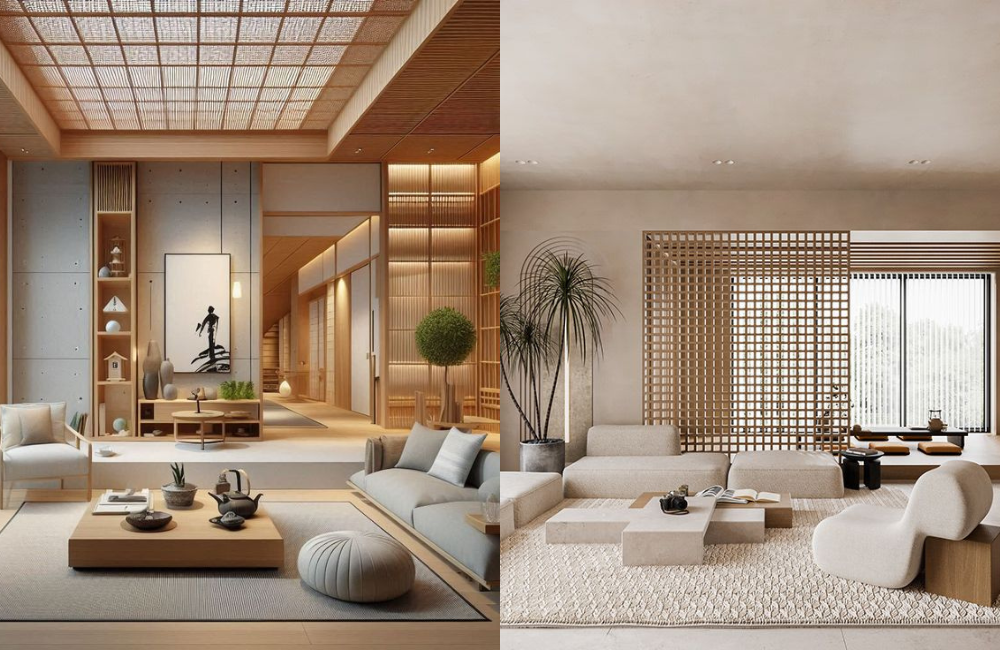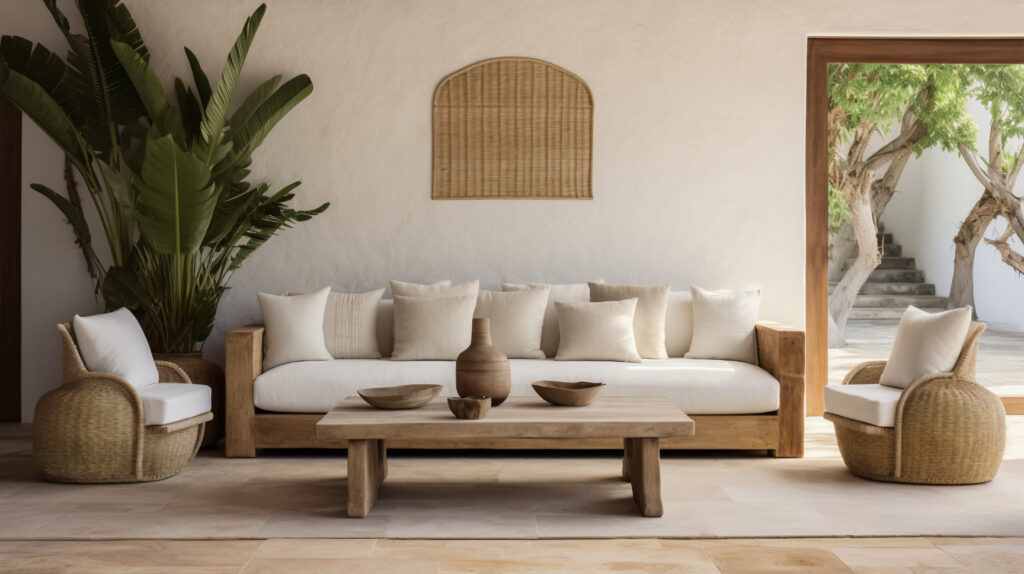In today’s fast-paced world, the concept of home as a sanctuary has become more essential than ever. Interior design is no longer just about aesthetics—it’s about creating an environment that nurtures peace, comfort, and functionality. Among the most sought-after design trends in recent years are Japandi and Zen Style, both rooted in Japanese principles of minimalism, harmony, and connection with nature.
Japandi, a fusion of Japanese and Scandinavian design, blends the best of both worlds: the clean, understated elegance of Japanese interiors with the warmth and coziness of Scandinavian aesthetics. Meanwhile, Zen Style is all about creating a peaceful retreat that promotes mindfulness and relaxation through simplicity, natural materials, and a clutter-free environment.
In this article, we’ll explore how you can bring Japandi and Zen design into your home, from selecting the right furniture and color palette to applying key principles that define these timeless styles.

What is Japandi and Why is It So Popular?
Japandi is a harmonious blend of Japanese wabi-sabi philosophy and Scandinavian hygge living, resulting in a design style that is both minimalist and inviting. While Japanese interiors are known for their structured simplicity and appreciation of imperfection, Scandinavian design is celebrated for its emphasis on coziness, warmth, and functionality. Together, they create a balanced and tranquil atmosphere that feels both refined and welcoming.
Key Elements of Japandi Design
- Minimalist yet functional furniture: Every piece has a purpose, with an emphasis on clean lines and simple forms.
- Earthy, muted color palettes: Soft neutrals like beige, gray, taupe, and warm browns dominate Japandi spaces.
- Natural materials: Wood, bamboo, linen, stone, and rattan enhance the organic feel of the interior.
- Handcrafted and sustainable decor: Japandi interiors often feature artisanal ceramics, woven baskets, and hand-carved wooden details.
- Uncluttered, open spaces: Storage is discreet and integrated into the design to maintain a sense of order and calm.
Japandi has become increasingly popular as people move away from excessive ornamentation and towards a simpler, more meaningful way of living. It’s a style that resonates with those who appreciate high-quality craftsmanship, sustainable materials, and serene environments.

The Foundations of Zen Interior Design
While Japandi incorporates Scandinavian elements, Zen Style stays true to the core principles of traditional Japanese interiors, focusing on balance, stillness, and a deep connection to nature. Inspired by Zen philosophy, this design approach promotes calmness and mindfulness, making it an ideal choice for those looking to create a stress-free living space.

Key Features of Zen Style
- Soft, natural color schemes: White, light gray, soft beige, and muted green create a soothing atmosphere.
- Low-profile furniture: Inspired by traditional Japanese homes, Zen interiors favor low tables, floor cushions, and platform beds.
- Natural light and open layouts: Large windows, sheer curtains, and minimal partitions enhance the feeling of openness.
- Organic materials: Wood, stone, and linen help create an authentic and peaceful environment.
- Minimalistic decor: Simple yet meaningful objects, such as bonsai trees, stone sculptures, or calligraphy artwork, add character without overwhelming the space.
Zen design is not just about appearance—it’s a way of life, encouraging simplicity, mindfulness, and appreciation of the present moment.
How to Incorporate Japandi & Zen Style into Your Home
1. Choosing the Right Furniture
Both Japandi and Zen styles emphasize functional, aesthetic, and uncluttered furniture. The key is to select pieces that serve a purpose while maintaining a refined, minimalist form.
- Sofas & Chairs: Opt for low-profile seating with natural upholstery in neutral tones. Japandi-style sofas are typically 35-45 cm off the ground, enhancing the grounded feel of the space.
- Tables: Choose simple wooden coffee tables around 40-50 cm high, preferably with rounded edges for a softer, more organic look.
- Beds: Platform-style beds or futon mattresses are common in Zen interiors, often 25-40 cm from the floor to maintain an airy and minimalist aesthetic.
- Storage Solutions: Avoid bulky furniture—go for built-in storage, open shelving, or discreet cabinets that blend seamlessly with the walls.
2. Selecting a Soothing Color Palette
The color scheme in Japandi and Zen interiors is all about calm, muted tones inspired by nature. These colors create a serene, warm atmosphere that promotes relaxation.
- Base Colors: Soft whites, warm beige, light gray, and natural wood shades.
- Accent Colors: Olive green, dusty blue, and earthy brown add depth while maintaining a natural balance.
- Dark Contrasts: Occasional black, charcoal, or deep brown accents in furniture or decor can create a striking yet subtle contrast.
3. Integrating Natural Elements
Japandi and Zen designs are deeply connected to nature, incorporating organic materials and biophilic elements to foster a sense of tranquility.
- Wood: Light oak, walnut, and bamboo are ideal for furniture and flooring.
- Stone: Marble, slate, or textured concrete can be used for countertops, walls, and decorative accents.
- Textiles: Cotton, linen, and wool add softness and texture to the space.
- Greenery: Bonsai trees, bamboo plants, and potted ferns bring life and freshness to the environment.

4. Creating a Tranquil Ambiance
Lighting plays a crucial role in enhancing the peaceful energy of Japandi and Zen interiors.
- Use warm, indirect lighting from paper lanterns, recessed ceiling lights, and wooden pendant lamps.
- Maximize natural light with large windows and sheer curtains.
- Incorporate soft candlelight or minimalist floor lamps to add warmth in the evening.
5. Emphasizing Open Space and Flow
The layout of a Japandi or Zen-inspired home should prioritize openness and movement, with minimal distractions and a focus on balance and proportion.
- Arrange furniture in a way that promotes easy movement and relaxation.
- Keep decorations intentional and sparse rather than cluttering the space with unnecessary items.
- Use sliding doors or dividers instead of solid walls to create a sense of flexibility and openness.
How Zory.ai Makes Japandi & Zen Design Easy to Achieve
If you’re inspired to bring Japandi or Zen aesthetics into your home, Zory makes the process effortless with its AI-driven furniture recommendations.
- Instead of endlessly searching for the perfect Japandi or Zen-inspired pieces, Zory.ai provides personalized selections tailored to your taste.
- You can browse pre-designed interiors, helping you visualize how different furniture and decor elements come together.
- With AI-powered tools, you can see how furniture fits within your space before purchasing, ensuring a cohesive and balanced design.
Conclusion
Whether you’re drawn to the warmth and functionality of Japandi or the calm simplicity of Zen, integrating these styles into your home can transform your space into a haven of tranquility and beauty. By focusing on natural materials, neutral tones, and thoughtful layouts, you can create an interior that promotes relaxation, mindfulness, and timeless elegance.
With Zory’s AI-powered platform, achieving Japandi and Zen aesthetics has never been easier. Explore the latest furniture selections, receive expert recommendations, and shop effortlessly—all in one place.
Ready to bring serenity and style to your home? Discover Japandi and Zen-inspired furniture with Zory today!
